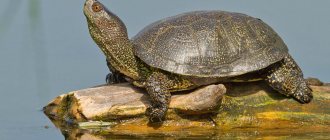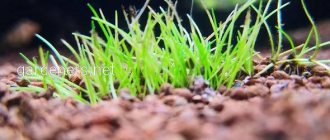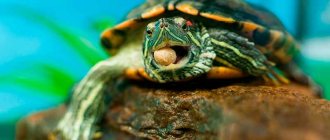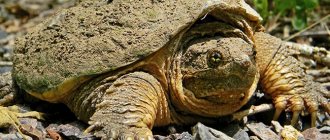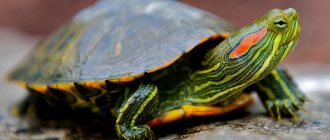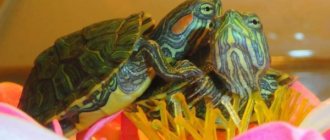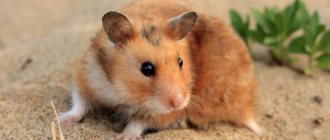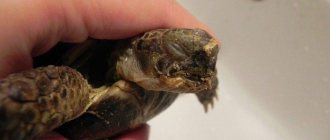Even in the most ancient times, humanity tried to tame wild animals, keeping them with them as their most faithful and devoted friends. Everything flows, everything changes, but not this habit. The only difference is that previously it was customary to have cats, dogs and parrots, but now they have more exotic pets - chinchillas, newts and even a marsh turtle.
Swamp turtles love ponds with stagnant water
Description of the marsh turtle
If we were painting a portrait of a marsh turtle, then its most important detail would look like this: an almost oval carapace of small height (about the term - help below), in which the width of the rear part is clearly greater than the front. In the largest individuals, the length of the carapace reaches 20 centimeters or more .
The carapace is the convex dorsal shield of a turtle's shell, consisting of a bone base and a horny covering.
Due to the fact that these turtles mainly live in the water element, the carapace of the animal is tightly pressed to each other, and it itself is streamlined in shape, without any protrusions, the fingers are connected by membranes. The turtle's paws have large and sharp claws, which is logical, since it is a predator. With their help, the turtle is able to tear its prey apart (your hand will not be the object of the hunt, but you should not let your guard down when communicating with your pet).
The tail of this reptile is quite long (up to 12 cm, which is often ¾ of the entire length of the shell). Its main function in the water is to guide and assist in maneuvering, creating a counterweight and maintaining balance during sharp turns. Moreover, in females it is shorter than in males.
The average weight of a reptile is 1.5 kg.
As for the color scheme, the swamp pet’s carapace is usually dark (from olive and khaki to almost black), but the plastron is light (closer to yellow). The body is densely covered with small light splashes and spots. Eyes depend on gender: in males they are most often red, and in females they are light shades .
Habitat
The known European marsh turtles can be seen in large numbers in Europe, Asia or Africa. Their habitats are bodies of water (from swamps to streams, rivers and ordinary puddles somewhere in the forest). Water is an absolute comfort for them, but they also love to bask in the sun, and to do this they have to crawl onto the shore or rocks protruding upward. These creatures try to catch the sun's rays even on the coolest and gloomiest days. But as soon as the turtle hears an extraneous sound, it will immediately run into shelter (water) from the unpleasant attention. Strong paws allow the swamp beauty to swim quickly, and its claws allow it to instantly bury itself in the mud or under foliage near the shore.
With the arrival of cold weather, in mid-autumn, picky animals hibernate : this is how they escape the winter cold. With the warmth of spring, they wake up again.
Basic diet of a reptile
The bog turtle is a predatory animal. In its natural habitat, it eats fish, small frogs, mollusks, woodlice, worms, and insect larvae. She also feasts on coastal and aquatic plants. Dry food is not suitable for her. This reptile needs live or frozen food. The main food for a turtle is fish. It is better to give her small live fish, which can be immediately released into the aquarium.
In captivity, the turtle is fed lean fish, shrimp, earthworms, and squid. Adult reptiles need plant food, so you can add cabbage, lettuce, dandelions, and duckweed to the animal’s diet.
A turtle's weekly diet should consist of 70% fish, 20% meat . The remaining 10% should include shellfish, snails, insects and plant food. With this diet, the turtle will be full and healthy.
What to feed a swamp turtle?
Thanks to the omnivorous nature of the European tortoise, it is not difficult to create a diet for its diet, but here you need to remember one important point: when feeding, your pet will be very aggressive. In this regard, when feeding fish, beef hearts, shrimp, liver, frogs, crickets, mice, snails or other food, remember to be careful, there is a risk of losing a finger or injury to a limb.
If you give your pet live food from time to time (for example, throw live fish into the water, which it will eat completely), it will retain its ability as a hunter. The younger the turtle, the more often it should be fed. But you can’t overfeed the animal, since by nature these reptiles are gluttonous.
The optimal feeding frequency is once a day for young animals and once every 2-3 days for adults.
How to keep a marsh turtle so that it is comfortable in your house or apartment, and the pet does not get sick? Diversify your diet with special vitamins and calcium. A good ready-made food should include such additives, and if you are a supporter of natural food, follow a healthy diet yourself. a sufficient amount of vitamin B3 must be produced in the pet’s body , and this is achieved by a certain solar spectrum - purchase a UV lamp for heating.
Land zone
It is needed so that reptiles can rest, warm up and dry out their shells.
The optimal temperature in the area of a land island is considered to be 30–35 degrees above zero, which is achieved by installing an ordinary incandescent lamp over this area.
It should be placed at a height of 25–30 cm from the surface of the land so that the animal does not receive burns. In addition, you should install a small ultraviolet lamp.
The fact is that UV rays promote the production of calcium in the turtle’s body, which is vital for the proper formation of the shell.
Many experts recommend feeding the animal on such an island, gradually accustoming it to this. If you achieve this “land” method of feeding, the water will maintain its purity longer.
Conditions for keeping a swamp turtle
You can understand whether a marsh turtle can be domestic or not by the fact that there is no need to create a swamp for it in the owner’s apartment. A terrarium or aquarium is quite suitable for her. However, new properties must be very spacious: at least 120 liters for one individual. The territory is conventionally divided into 2 parts (island and water), between which a connection is installed in the form of a ladder. The depth of the liquid should be at least 15-20 cm. Above the land, at a height of at least 20 cm, we place a UV lamp with a heating function. Additionally, you will need a filter and a heater for water (used when the temperature drops below 20 degrees). It is also important to monitor the air temperature (directly under the UV lamp it should not be above 28 degrees and below 23) . When the thermometer is low, the reptile can fall asleep for a long time, and it is quite difficult to bring the turtle out of hibernation. If it is too high there is a risk of burns. When artificially determining the length of daylight hours, focus on half a day (12 hours).
To prevent your beauty from polluting the water during feeding, you can transplant her during meals to a place that will become a “dining room” - a basin or a separate bath. After this, the pet returns to its habitat.
For aesthetes, we inform you: turtles do not need any additional decor (from a nice flooring to plants inside the aquarium). And such minimalism will make it much easier for you to clean your turtle’s home and take care of it.
Taming a swamp turtle
There are swamp turtles that are distinguished by a strong level of aggressiveness. This must be taken into account when picking up your pet. The correct way to do this is to take the animal by the edge of the back of the shell to protect yourself from the head on a fairly long neck. However, many owners, when caring for swamp turtles, note that the latter are shrewd enough not to bite. On the contrary, they even stretch their heads towards the owner. And some owners initially teach the animal to eat with tweezers.
Some experts on European marsh turtles are sure: if you follow all the recommendations for keeping a marsh turtle at home (regularly feed your pet, care for it, set an exact feeding schedule), then the predator will even begin to recognize the person. And your visit will be an impetus for him to a conditioned reflex and almost friendly behavior. Be patient - everything will work out.
In the communication of these reptiles with children, other animals and their fellow tribesmen, it is believed that such contacts are best limited; remember the bloodthirstiness of turtles. They behave biasedly even towards their own brothers-in-arms and often hurt each other. Attempts to create a common territory for several individuals in one aquarium often ended with someone becoming not just a rival, but also food.
Availability
The bog turtle can be found commercially or caught in the wild during the warmer months. But, with normal maintenance, owners with zero experience in breeding turtles successfully produce offspring.
All individuals kept in captivity are unpretentious and easy to care for.
However, it is important to note that to keep a marsh turtle, you need to create fairly precise conditions. And just bringing it and putting it in a basin won’t work. If you catch a turtle in the wild and you only need it for fun, then leave it where you found it. Believe me, this way you will make your life easier and will not kill the animal.
About turtle health and diseases
Common diseases among these creatures are various types of pneumonia, skin fungus, etc. Swamp turtles are not as hardy as red-eared turtles, and therefore require special attention, responsibility and health care. So, if the European marsh turtle is not kept at home correctly, the pet may die . This is why proper care of it is important. Are you able to create it?
A number of turtle ailments are directly related to unsanitary conditions in their territory. For example, dirty water often leads to bacterial eye diseases or infectious inflammation. Therefore, it is necessary to frequently change the liquid, clean the space, or place the pet separately in the “dining room” during feeding.
Characteristics of this species
The European marsh turtle is characterized by a brown-brown or dark olive oval shell (carapace) with diverging lines or bright yellow dots, paws with sharp claws (4 claws on the hind legs and 5 on the front) and moderately developed swimming membranes, a long tail . The head and paws are decorated with yellow spots. The plastron is lighter, ranging in color from yellow to dark brown with black.
The color of the shell can change as it grows and forms. Newborn turtles are almost entirely black with a yellow rim along the edges of the plastron and carapace. Turtles lighten with age and become covered with a bright yellow pattern, the plastron also turns yellow, and the carapace changes from brown to dark olive. Depending on the subspecies, the length of the shell reaches 18–25 cm, and males are usually smaller than females. In nature they live up to 120 years.
Care
Caring for a marsh turtle is not difficult, the main thing is to recreate natural conditions. Maintain the aquaterrarium in a timely manner, monitor the diet and temperature, monitor your pet, and if you suspect an illness, do not delay treatment, then the marsh turtle will live a long time.
Stern
Unlike land turtles, European marsh turtles are predators. Feed your pet a variety of foods:
- lean fish (haddock, pollock, cod, perch);
- small snails and crustaceans;
- earthworms;
- bloodworm;
- mussels;
- shrimp;
- baby frogs;
- live aquarium fish;
- branded food.
Protein foods are the basis of the diet. Serve moist food at room temperature. Vegetable feeding is also required (15% of the diet):
- dandelion leaves;
- salad;
- spinach;
- non-acidic fruits;
- carrot;
- duckweed.
While feeding, the reptile scatters pieces of food and quickly pollutes the water. To keep the water clean, feed the animal in a different container. Give food to young individuals and pregnant females every day, to adults - once every 2-3 days. Unlike land turtles, European marsh turtles are easy to train. Feed with tweezers, pets will stretch their heads to take food. Hand feeding is not advisable, as later the animal associates hands with eating, which makes independent feeding difficult. Nutrition occurs in water.
Hygiene
It is enough to wipe the shell of a swamp reptile with a soft sponge or brush without soap once a week. Use warm water. If the turtle is not in the mood, wait for the right moment.
Age determination
Find out the age of the reptile by the rings on the scutes of the shell. During the first two years of life, the growth ring appears within 3–6 months. After this, one ring is added annually. The pattern of an elderly marsh turtle is unclear. You can also find out the approximate age of a reptile by the length of its shell. In newborns, the length of the shell is up to 3 cm; every year the shell becomes 2 cm longer. By one year, the reptile has a 5-centimeter shell, while a two-year-old turtle has 7 cm.
Arrangement of the terrarium
European marsh turtles spend a lot of time in the water, and this must be taken into account when keeping them in the house. A terrarium for a reptile should be spacious, with a volume of at least 100 liters. Breeders claim that the larger the terrarium, the larger the turtle will grow. It is better to take not a tall, but a wide aquarium and arrange an island of land in it, which usually occupies a third of the entire area. For these purposes, it is permissible to use a large stone with gentle edges and beautiful driftwood.
For a comfortable existence in the terrarium you should install:
- a lamp for heating the air, which is installed above the island;
- an ultraviolet lamp, which is needed to maintain health;
- filters for water purification, which keeps the terrarium clean;
- special bottom soil that makes it look like the bottom of a lake;
- edible seaweed for the turtle to snack on.
You should not choose algae with intense growth force, otherwise they will occupy the entire space of the terrarium.
Temperament
Swamp turtles are an extremely responsive species to tame. They quickly lose their fear of people. Reptiles quickly associate eating with the arrival of a person. When they notice the owner of a vivarium or pond at a distance, the reptiles actively move towards him. Turtles swim, deftly climb out of the water to get to the food served by humans.
Ready food
Feeding a red-eared turtle exclusively with dry food is highly discouraged, but ready-made food can be included as an addition to the main diet, which should make up no more than 5-10% of the total diet. There are several manufacturers with more or less balanced nutrition for turtles. These include:
- Tetra,
- Nutra Fin,
- JBL,
- Sera.
A wide range of such food is produced in the form of flakes, tablets, granules and even capsules.
DIY turtle food
You can prepare food for your red-eared turtle at home.
For these purposes the following ingredients are needed:
- 70 grams of carrots,
- 50 grams of apples,
- 50 grams of white cabbage,
- 100 grams of squid meat,
- 150 grams of fish.
All this is passed through a meat grinder. Two eggs, prepared gelatin (dilute 30 grams in 150 ml of hot water until completely dissolved), 150 ml of milk are added to the mixture.
After stirring, let it cool and add twenty drops of the vitamin balance-correcting drug Tetravit.
This food can be stored in the refrigerator for one week. Before use, it must be cut into pieces. This volume of food is enough for 10 feedings for a turtle with a shell fifteen centimeters long.
Sense organs
This animal is distinguished by a high level of development of sensory organs. The main features are as follows:
- Vision. Red-eared turtles distinguish colors, choose the most suitable places to lay eggs, and look for other turtles. They also see moving objects, the distance to which can reach 40 m, well distinguishing predators and prey from each other.
- Smell. These reptiles search for food thanks to their developed sense of smell.
- Hearing. These animals hear poorly. This is due to the fact that their ears are hidden under the skin. Therefore, red-eared turtles react only to vibration.
- Touch. The turtle's shell is equipped with nerve endings, so it feels touch. The presence of taste buds allows these creatures to choose tastier foods.
- Voice. The vocal apparatus of turtles is not developed; they are only capable of snorting and hissing. Sometimes they make a squeak.
Reviews
German Leonidovich, 34 years old, Kharkov
I work in a clinic and periodically I get so tired of the noise and bustle that I come home to relax. Unfortunately, I am allergic to wool, so I got myself a river turtle as a pet. What can I say: calm, flexible, quite intelligent. I can’t assure that this is a girl (my friends brought her to me), but for some reason I wanted to name her Dusya. Sometimes we are very close and spend time together, watching TV, and I stroke her shell. And, by the way, the river turtle turned out to be not a river turtle at all; it spends most of its time on land. In short, this is the most docile pet, quiet, calm, and does not eat very much. Dusya is the only turtle so far, but not the last, soon I want to finally find out her gender and find her a boyfriend or girlfriend.
Daria Viktorova, 21 years old, Solnechnogorsk
My father brought me a river turtle when he was returning from a business trip in his car. According to dad, she ran through his path. He was afraid of crushing her and braked in time, got out, took her in his arms and decided to give her to me. Then Krosh was very small, but in 7 years he grew up and became quite a large individual. He doesn’t really like water, and if I put him in the bath and try to move away, Krosh tries to get out, he asks to come to me. There was a time when it seemed to me that he was sick. No matter what I gave him to eat, he refused. It even seemed to me that his shell would soon completely fall off, because he was becoming softer and softer. It turns out that he simply did not have enough food fortified with calcium. Since then, I periodically pamper my pet with snails and shrimp.
Danila Arsenievich, 54 years old, Kislovodsk
My wife and I spend most of our time in the city, but on weekends we come to the dacha to visit our turtle Masha. Our grandchildren caught it for us not far from the river. Since then, Masha lives most of the time with a neighbor, and when we arrive at the dacha, we take her to our place. In summer and spring we release it onto the lawn. When we were young, we kept both hamsters and parrots - everything was not the same, they either made noise or smelled. But with our Masha there are no such worries.
Animal feed
Young sliders should consume at least 70% animal food in their daily diet. Whereas older reptiles can completely switch to a plant-based diet or maintain meat consumption at 10-25%.
The turtle can eat raw and boiled (without salt and spices) pieces of lean meat:
- bird,
- rabbit meat,
- horse meat,
- beef.
Another element of the diet is offal:
- heart,
- navels,
- liver.
Smaller mice are also suitable for feeding.
The slider will not be able to digest fatty types of meat such as lamb or pork.
The fish is suitable for low-fat river fish, from which you need to remove the giblets and bones
It is important to soak the fish in hot water for a few minutes before eating to destroy the thiaminase enzyme to prevent the development of vitamin B1 deficiency.
Aquarium fish can be used as food. For example, swordtails, guppies, goldfish.
As a change to the main diet, a raw mixture of squid, green shrimp and octopus is added. It is sometimes acceptable to give the meat of some snails - mariz, coils, pond snails.
You can diversify the menu with the help of insects. You can feed your red-eared turtle:
- crickets,
- bugs,
- bloodworm,
- grasshoppers
- and even caterpillars.
You can add live or dried gammarus, daphnia and coretra - but this is done occasionally.
You should avoid pet cockroaches because these insects are often poisoned.
Madagascar cockroach
Reproduction
In the spring comes marriage time. During this period, turtles (age 6–8 years and shell 9–12 cm) are far from water bodies. Turtles can also mate in water. The sperm of turtles can be stored in the female’s tract for up to 1 year or more; as a result, a female caught in the wild can “personally” lay completely full-fledged eggs after 5-6 months. Between May and July, females lay eggs three times in holes dug in the ground. During the season, the female produces 1–3 clutches. The depth of the pits is approximately 10 cm. The eggs that fall into them are beautiful: their shells are snow-white, they themselves have an oblong, regular shape, size 30 x 20 millimeters, weight approximately 8 g. In any clutch there are about 5–10 eggs, and they The female buries it most carefully. After approximately 2-3 months, these eggs produce tiny turtles about 24–25 millimeters long, weighing 5 g, with a large yolk sac on the belly. The shell of young turtles is usually dark brown with yellow lines. They dig small tunnels near the nest, where they spend the winter in most cases. In the spring, turtles crawl out of their shelters onto the surface of the earth and begin an independent life. The incubation temperature is about 25–30°C and the duration is 54–90 days. Incubation humidity 90%. The water depth for newly born turtles is approximately 5 cm. Young individuals feed on daphnia and insect larvae.
Selecting the site language
Afrikaans Albanian Amharic Arabic Armenian Azerbaijani Basque Belarusian Bengali Bosnian Bulgarian Catalan Cebuano Chichewa Chinese (Simplified) Chinese (Traditional) Corsican Croatian Czech Danish Dutch English Esperanto Estonian Filipino Finnish French Frisian Galician Georgian German Greek Gujarati Haitian Creole Hausa Hawaiian Hebrew Hindi Hmong Hungarian Icelandic Igbo Indonesian Irish Italian Japanese Javanese Kannada Kazakh Khmer Korean Kurdish (Kurmanji) Kyrgyz Lao Latin Latvian Lithuanian Luxembourgish Macedonian Malagasy Malay Malayalam Maltese Maori Marathi Mongolian Myanmar (Burmese) Nepali Norwegian Pashto Persian Polish Portuguese Punjabi Romanian Russian Samoan Scottish Gaelic Serbian Sesotho Shona Sindhi Sinhala Slovak Slovenian Somali Spanish Sudanese Swahili Swedish Tajik Tamil Thai Turkish Ukrainian Urdu Uzbek Vietnamese Welsh Xhosa Yiddish
Dermatomycoses
Most often they arise due to gross violations of the conditions of detention, as a result of which the immunity and general resistance of the body are reduced. They are characterized by lesions of the skin or shell, in which a dirty gray coating appears on their surface, which later leads to the death of the tissue underneath. In this case, detachment of individual plates of the shell and its deformation may also occur.
Treatment must be started as early as possible; only in this case can success be achieved. For therapy, a solution of malachite green is used at a concentration of 0.15 mg per 1 liter of water. A turtle is bathed in it for 3 days for 15-20 minutes. After which the damaged areas are treated with Canesten cream.
If the lesion is severe, the intervention of a veterinarian will be required, who will remove the affected areas surgically. Also, in some cases, when bathing a turtle, it may experience eye irritation. The best prevention of dermatomycosis is good living conditions and a balanced diet.
For aquatic turtles
The optimal diet of an aquatic turtle is much more complex than that of a land turtle. It should be borne in mind that full-fledged live feeding is quite difficult here, since in nature such animals feed exclusively on fresh fish.
And seafood, which is offered in domestic stores, goes through cycles of freezing and thawing several times. This leads to the destruction of nucleic acid proteins, as well as oligoelements, which are vital for the predatory sea turtle.
Therefore, the addition of dry food saturated with appropriate microelements is a prerequisite for creating a complete diet. It is imperative to check whether the food contains fat-soluble vitamin complexes, of which vitamins A and E are considered the most popular.
